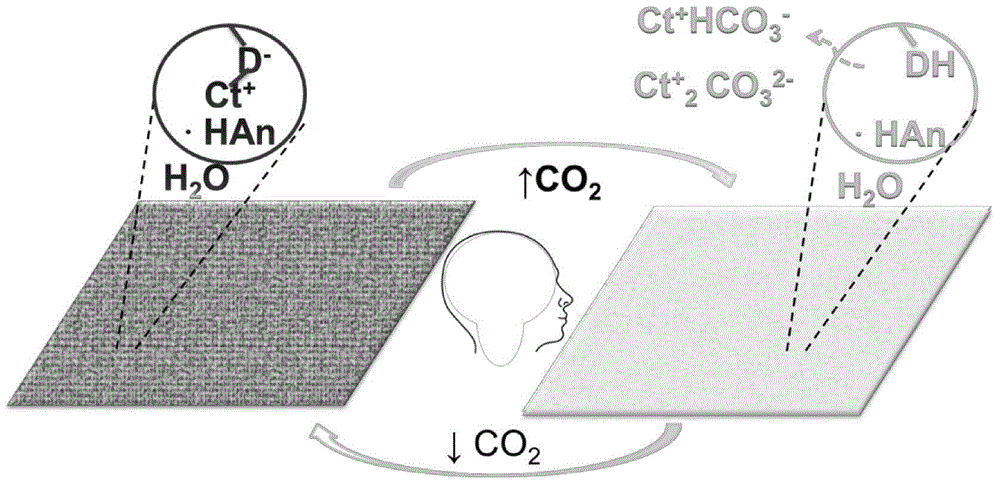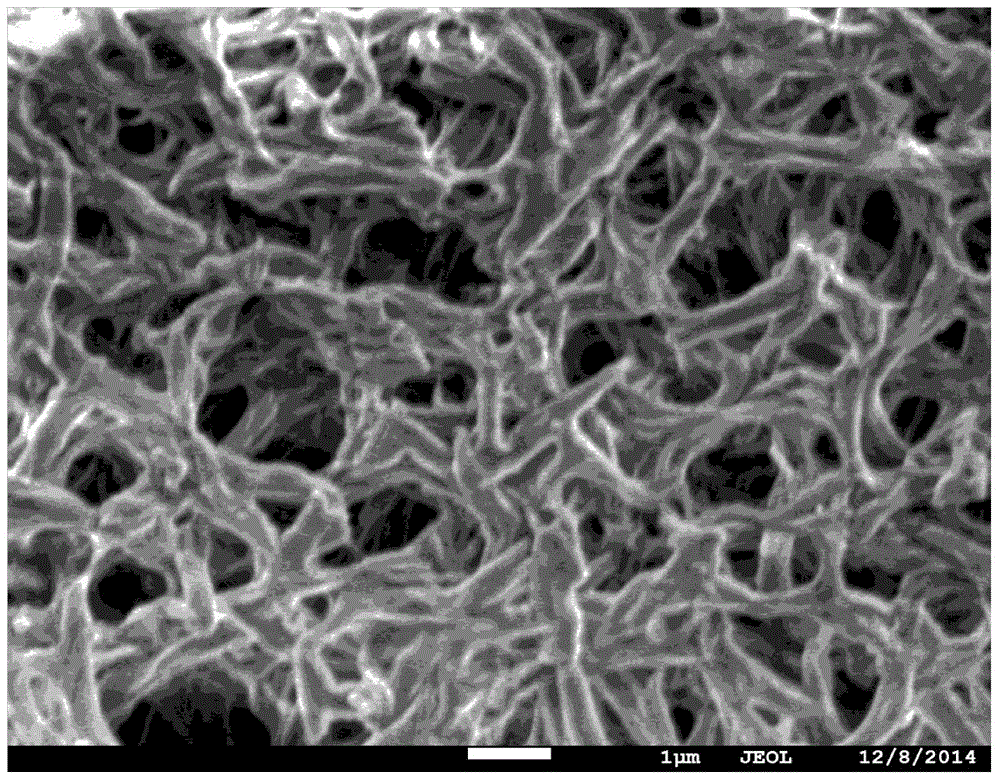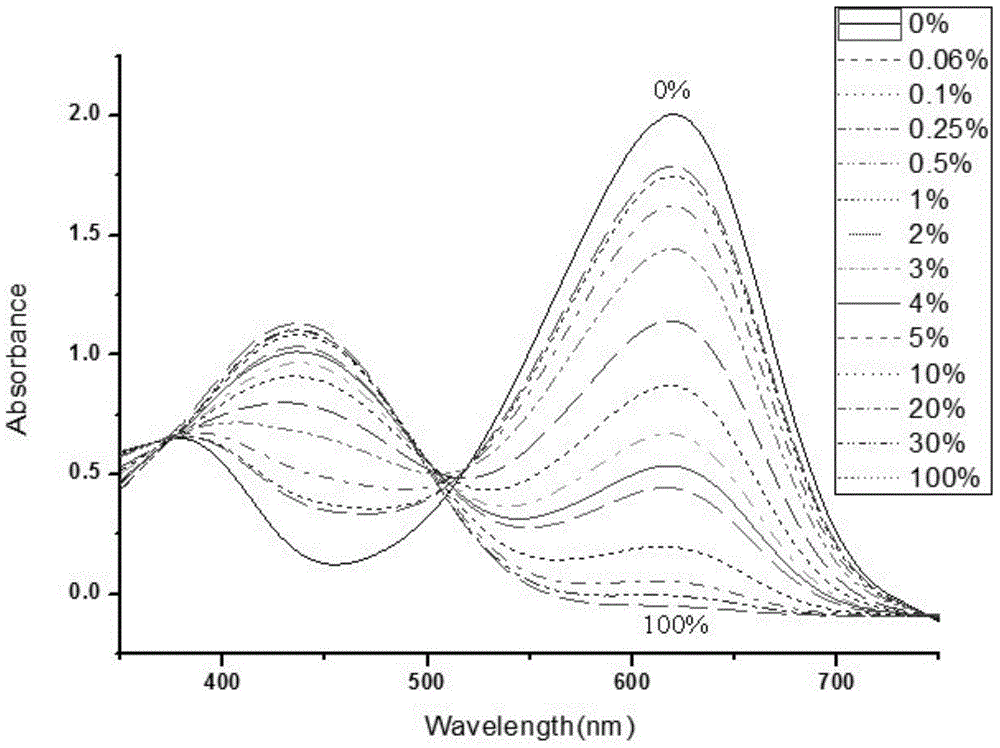Thin film sensor for detecting carbon dioxide and application of thin film sensor
A thin-film sensor and carbon dioxide technology, which is applied in the direction of analyzing materials through chemical reactions and observing the impact on chemical indicators, etc., can solve the problem of large volume, long time for patients to carry monitoring platforms, and complex structures. and other issues to achieve the effect of large specific surface area
- Summary
- Abstract
- Description
- Claims
- Application Information
AI Technical Summary
Problems solved by technology
Method used
Image
Examples
Embodiment 1
[0047] In this example, thymol blue is used as the indicator, the cation of the carrier complex is quaternary ammonium ion, the anion is hydroxide ion, and the porous film is nylon 6 material. The specific preparation is as follows:
[0048] Dissolve 5.0g of tetraoctylammonium bromide and 0.74g of hexadecyltrimethylammonium bromide in methanol into a 15ml solution, put it into a 50ml flask, and slowly add 1.82g of silver oxide under vigorous stirring powder. Vigorously stirred at room temperature for one hour and then filtered to obtain a methanol solution of mixed alkylammonium hydroxides, which was colorless or pale yellow. Dissolve 0.02g of thymol blue solid powder in 2ml, 0.7mol / L methanol buffer solution of mixed alkylammonium hydroxide, shake slightly to fully dissolve the solid, and the solution is dark blue at this time. In another flask, 5ml of toluene was added, and 1g of ethyl cellulose powder was slowly added to the flask under vigorous stirring to make it fully ...
Embodiment 2
[0070] In this example, m-cresol violet is used as the indicator, the cation of the carrier complex is quaternary ammonium ion, the anion is hydroxide ion, and the porous matrix film is nylon 6 material. The specific preparation is as follows:
[0071]Dissolve 5.74g of dodecyltrimethylammonium bromide with methanol to a solution of 15ml, put it into a 50ml flask, and add 1.82g of silver oxide powder under vigorous stirring. Stir at room temperature for one hour and then filter to obtain a methanol solution of dodecyltrimethylammonium hydroxide, which is colorless or light yellow. Dissolve 0.02g m-cresyl violet solid powder in 2ml, 0.7mol / L methanol solution of dodecyltrimethylammonium hydroxide, shake slightly to fully dissolve the solid, and the solution is now purple. In another flask, 5ml of toluene was added, and 1g of ethyl cellulose powder was slowly added to the flask under vigorous stirring to make it fully dissolved, and then 1g of monodisperse porous silica microsph...
Embodiment 3
[0077] In this example, thymol blue and phenol red were used as indicators, quaternary ammonium ions were used as cations of the carrier complex, hydroxide ions were used as anions, and nylon 6 material was used for the porous matrix film. The specific preparation is as follows:
[0078] Dissolve 5.74g of tetraoctylammonium bromide with methanol to a solution of 15ml, put it into a 50ml flask, and add 1.82g of silver oxide powder under vigorous stirring. Stir at room temperature for one hour and then filter to obtain tetraoctyl ammonium hydroxide methanol solution, which is colorless or light yellow. Dissolve the solid powder of 0.01g thymol blue and 0.01g phenol red in 2ml, 0.7mol / L methanol solution of tetraoctyl ammonium hydroxide, and shake slightly to fully dissolve the solid. At this time, the solution is blue-purple. That is, the indicator methanol buffer solution. In another flask, 5ml of toluene was added, and 1g of ethyl cellulose powder was slowly added to the fla...
PUM
| Property | Measurement | Unit |
|---|---|---|
| pore size | aaaaa | aaaaa |
| diameter | aaaaa | aaaaa |
| pore size | aaaaa | aaaaa |
Abstract
Description
Claims
Application Information
 Login to View More
Login to View More - R&D
- Intellectual Property
- Life Sciences
- Materials
- Tech Scout
- Unparalleled Data Quality
- Higher Quality Content
- 60% Fewer Hallucinations
Browse by: Latest US Patents, China's latest patents, Technical Efficacy Thesaurus, Application Domain, Technology Topic, Popular Technical Reports.
© 2025 PatSnap. All rights reserved.Legal|Privacy policy|Modern Slavery Act Transparency Statement|Sitemap|About US| Contact US: help@patsnap.com



